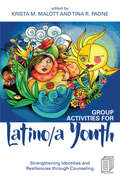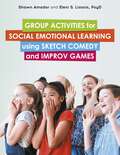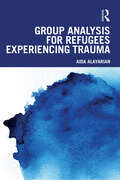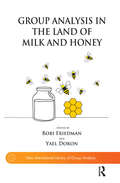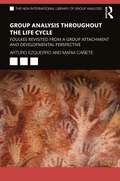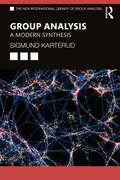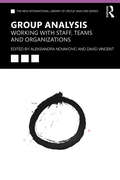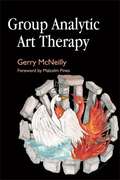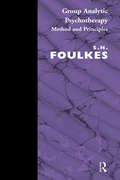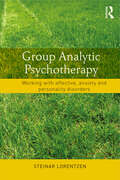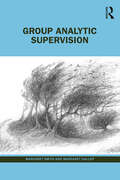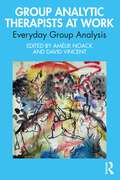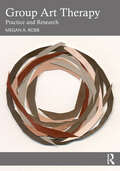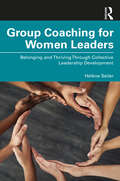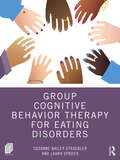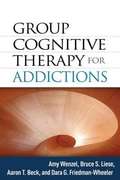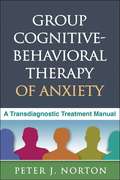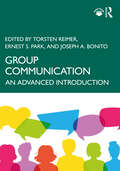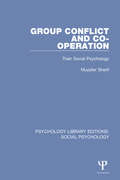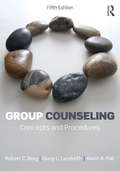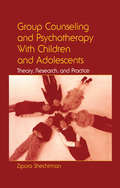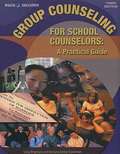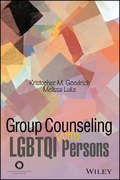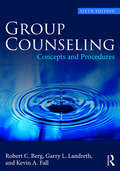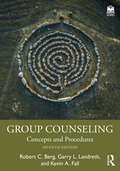- Table View
- List View
Group Activities for Latino/a Youth: Strengthening Identities and Resiliencies through Counseling
by Krista M. Malott Tina R. PaoneDirectly applicable to practice, Group Activities for Latino/a Youth allows helping professionals such as human service workers, social workers, and school and community mental health counselors to select and apply a series of group sessions with topics relevant to today’s Latino/a youth. Each session contains detailed directions, suggested discussion questions, and additional readings on specific topics, with topic examples including grief, identity development, and conflict resolution. Sessions draw on Latino/a cultural norms and strengths to build culturally-informed communication and coping skills in an effort to improve educational, social, and career outcomes. A developmental perspective is used, and sessions are designed to be creative and interactive in order to appeal to the high energy and playfulness of youth at any age. Group Activities for Latino/a Youth helps professionals to better engage and retain Latino/a clients, a group that traditionally experiences one of the largest drop-out rates in therapy, often due to interventions largely informed by dominant Anglo norms and traditions.
Group Activities for Social Emotional Learning using Sketch Comedy and Improv Games
by Shawn Amador Eleni LiossisChildren with strong social-emotional skills are better able to cope with everyday challenges and benefit academically, professionally, and socially. But the benefits that can be derived from these skills can only be seen if children are given the opportunity to develop them.This accessible guide helps teach children to participate in social-emotional learning. Offering fun group activities including social skill-based improv games, participant written plays, and basic plays that can be transformed using the creative minds of children themselves. To increase participant comfort levels with these activities, the book allows for a graduated exposure of techniques, starting with improv trust building and joint focus games, and progressing to improvisation and writing sketches.Featuring additional downloadable content, including worksheets and lesson plans for classroom use, this is the perfect companion for educators and therapists.
Group Analysis for Refugees Experiencing Trauma
by Aida AlayarianIn this prescient and sensitive volume, Aida Alayarian looks at how psychoanalysis in group settings can benefit refugees who have experienced trauma, with an express focus on transference and countertransference. Group Analysis for Refugees Experiencing Trauma offers a comprehensive overview of trauma from a psychoanalytic perspective, before delving into the nuance of trauma experienced by asylum seekers, refugees and those who have gone through forced migration. Through clinical vignettes, Alayarian highlights the importance of the resilience that can be brought about from group sessions and shared experience in helping to heal the wounds of trauma. She looks at the vital role of social injustice in this trauma and shows how this can be directly applied to work with other groups experiencing human rights violations, destitution, and loss. She shows how looking at relational patterns as a means of understanding conscious, unconscious, and subconscious thought processes can provide essential breakthroughs with patients, as well as the importance of paying close attention to countertransference to avoid a breakdown of the clinical relationship. Using psychoanalytic theories from intercultural perspectives to show the multidimensional nature of work with trauma patients, this book is essential reading for psychoanalysts, psychologists, psychiatrists, and other mental health experts working with refugees and patients experiencing trauma.
Group Analysis in the Land of Milk and Honey (The New International Library of Group Analysis)
by Yael DoronGroup Analysis in the Land of Milk and Honey is a collection of beautifully written clinical essays by group analysts in Israel - a society which suffers from chronic war and violence. Israeli group conductors share their experience and their special skills concerning the reflection of terror and existential anxiety in their group-analytic therapy groups. The topics range from the influence of society on the individual, the nature of the "group", combined individual and group therapy, groups with mentally ill and elderly patients, and coping with aggressive patients and the self-destructive processes that are ubiquitous in a society threatened with extinction. These group analysts discuss breaking of boundaries, "democracy in action", leadership, paternalism and fanatic identifications. The special place of Shoah survivors and of Arab and Jewish conflict make this book unique. The book conveys both the trauma and the creativity of Israeli society. The editors, Dr Robi Friedman and Yael Doron, represent different generations within the IIGA - the Israeli Institute of Group Analysis.
Group Analysis throughout the Life Cycle: Foulkes Revisited from a Group Attachment and Developmental Perspective (The New International Library of Group Analysis)
by Arturo Ezquerro María CañeteArturo Ezquerro and María Cañete present a captivating journey through human development, group lives and group attachment from infancy all the way into old age. Co-constructed with meticulous anthropological, psychosocial, cultural and clinical research, as well as true, stirring stories and insights which contain a rare blend of common sense and inspiration, this book offers an exciting new outlook on attachment and group analysis. Group Analysis throughout the Life Cycle first assesses psychosocial, peer group and other group developmental studies, within a broad evolutionary and cultural context, looking into changes and constancies, continuities and discontinuities, as well as overlaps that occur throughout each developmental stage. It then presents a thorough review of psychoanalytic, group-analytic and wider group literature. The book concludes with a consideration of qualitative group-analytic research which examines clinical group phenomena that can be present in all age groups, as well as distinct phase-specific characteristics and developmental tasks, as they find expression in the therapeutic process. Presented with frankness, self-reflective thinking and compassion, Group Analysis throughout the Life Cycle will be essential reading for psychotherapists, psychoanalysts, group analysts, psychiatrists and other professionals in practice and in training. It will also appeal to healthcare professionals interested in human development and attachment theory.
Group Analysis: A Modern Synthesis (ISSN)
by Sigmund KarterudGroup Analysis outlines how clinical group analysis can re-establish itself as a leading paradigm for group psychotherapy.Sigmund Karterud explains how the focus of group analysis and its applications can be expanded by stronger emphasis on the philosophy and psychology of the self. The book is divided into four parts, with part one reconsidering the historical roots of group analysis through its founder S. H. Foulkes and part two demonstrating how the fields of evolution, primary emotions, attachment, mentalizing, personality theory and personality disorders can be integrated with group analysis. Part three develops a philosophy of the self that includes a group self which accounts for the we-ness of groups, and part four illustrates how these concepts can inform the practice of group analysis through a series of clinical vignettes addressing the major challenges which face the clinician.Group Analysis: A Modern Synthesis will be essential reading for all group psychotherapists in practice and in training. It will also appeal to students of group analytic psychotherapy.
Group Analysis: Working With Staff Teams And Organizations (The New International Library of Group Analysis)
by David Vincent Aleksandra NovakovicFeaturing contributions from a range of organizational contexts, Group Analysis: Working with Staff, Teams and Organizations identifies the key features to group analytic practice as well as how different theoretical orientations, such as Systemic and Tavistock Consultancy approaches, can be incorporated into the process. The book addresses two essential features of group analysis: the exploration of unconscious dynamics in groups, and the shifts of observational attention between the group as a whole, the individual in the group, and the group in the individual. Including perspectives from both organizational consultancy and reflective practice, chapters feature analysis with groups and subgroups in a range of settings, including a forensic psychiatric hospital, a children’s hospice, an Anglican religious community and the management team of a global organization. Group Analysis: Working with Staff, Teams and Organizations is a major contribution to the developing literature on group analysis. It will be of great interest to psychotherapists, organizational consultants, facilitators of reflective practice groups, coaches, trainees in these disciplines, and any professionals who work with staff, teams, and organizations.
Group Analytic Art Therapy
by Gerry McneillyGroup Analytic Art Therapy, written by an internationally renowned psychotherapist, provides readers with a practical and theoretical framework for using group art therapy in a range of settings. Based on over 20 years' experience of conducting group art therapy, this book is packed with suggestions for group art therapy practice and many explanatory diagrams. The author also explores the dynamics and psychological effects of diverse group situations, based on examples from his own clinical practice, and offers an illuminating insight in to his own theories and practical applications of group art therapy in the context of the developments in the field. Group Analytic Art Therapy is both a comprehensive reference and an inspiring text for practising and trainee art therapists, psychotherapists and group therapists.
Group Analytic Psychotherapy: Method and Principles
by S.H. FoulkesThis book captures the flavor and spirit of the highly trained and experienced practitioner as he goes about the task of organizing and conducting a group. It also captures the warmth and humanity of a professional who is deeply devoted to his patients, his profession and humanity at large.
Group Analytic Psychotherapy: Working with affective, anxiety and personality disorders
by Steinar LorentzenGroup analytic theory is internationally recognised as an effective treatment for people suffering from mental distress, struggles with personal development and interpersonal problems. Integrating psychoanalytic and social psychological thinking and providing a group setting for self-discovery and developing social skills, long- and short-term courses in this type of therapy are increasing in popularity. This manual provides a detailed description of both long- and short-term versions of group analytic therapy, with rich and vivid clinical examples to illustrate theory and techniques. Group Analytic Psychotherapy describes in detail what a participant may expect, differences between short- and long-term therapy and how to behave as a group member, as well as the main issues the clinician has to deal with. Topics covered include: Group Analytic Theory Methodology Clinical Examples Therapist Adherence and Competence Providing a basis for understanding the dynamics of groups at work in offering emotional support and a positive atmosphere, Group Analytic Psychotherapy is ideal for clinicians, students and informed patients as well as all psychodynamically oriented professionals in the field. It is an essential manual for those looking to learn the main attributes of short-term intervention.
Group Analytic Supervision
by Margaret Smith Margaret GallopGroup Analytic Supervision uses group analytic concepts to cast light on how group supervision works, covering history, theory and practice. Margaret Gallop and Margaret Smith illustrate the benefits that supervision can provide for post-qualification group supervision. This book offers a model of group analytic supervision, the clinical hexagon, to support supervisors of groups in thinking about their supervision group and its process. Gallop and Smith use vignettes to illustrate how supervision groups work together to broaden and deepen their understanding of their clients, including examples that demonstrate the benefits of this multi-perspective approach for therapists providing dyadic therapy. Group Analytic Supervision addresses several of the key tasks for supervisors of groups, including establishing and maintaining boundaries around the work, establishing good working relationships, working with parallel process, transference and countertransference. It describes using difference and diversity to enrich learning and it stresses the importance of self-care. Group Analytic Supervision will be essential reading for anyone who is providing group supervision, particularly therapists who undertake group analytic training. It will also be of great interest to counsellors and therapists, social workers, probation officers and healthcare staff who both provide and receive group supervision.
Group Analytic Therapists at Work: Everyday Group Analysis
by David Vincent Amélie NoackGroup Analytic Therapists at Work is an accessible introduction to the experience of being in group analytic psychotherapy from a wide range of perspectives. Written by members of the Group Analytic Network London, the chapters explore the history of group analysis and span key areas, including the political and the social, diversity and difference, gender and norms, and isolation and the social sphere. Group Analytic Therapists at Work contains discussion of themes such as group work with differing age ranges and life stages, cultural considerations, normativity, inclusion and exclusion, isolation and the internet. Each chapter provides insight from an experienced group analyst into what happens in groups, what group analysts think about while running their groups and, fundamentally, what group analysis is about. This book will be of great interest to psychotherapists in practice and in training, group therapists and group analysts and other professionals, as well as anyone else seeking to increase their understanding of group work.
Group Art Therapy: Practice and Research
by Megan A. RobbGroup Art Therapy: Practice and Research is the first textbook of its kind, taking into account practice-based evidence and using a transtheoretical approach to present a range of art therapy group interventions. The book covers essential topics including leadership, art making, successful therapeutic factors, and the basic stages of developing and facilitating groups. Offering practical information not only to students but also to experienced practitioners, the chapters provide details about preparation and practice, note-taking and documentation, and research tips. Adhering to the most up-to-date educational standards and ethical codes of art therapy, the book covers the full range of settings and art therapy approaches. This text will prepare art therapy graduate students and practitioners to lead groups in a variety of settings, theoretical approaches, and applications.
Group Coaching for Women Leaders: Belonging and Thriving Through Collective Leadership Development
by Hélène SeilerThis book is an invaluable resource for those looking to lead high-functioning women groups, and a testament to the power of group coaching for women leaders.Dr. Hélène Seiler advocates for the expansion of group coaching to support the fulfilment of women leaders, providing a comprehensive review of the relevant academic literature on group coaching for women leaders and an in-depth analysis of her reflective notes over the last 15 years. This book shares the author’s experience as an international group coach and an executive coach for women leaders, and echoes the voices of her former group members. Using case studies and practical tips, the author offers recommendations when forming a new collective of women leaders, shares best practices in high-functioning groups, provides solutions when dealing with breakdowns within a group, and provides guidelines to lead change when a group composition evolves. This book also addresses the potential impact of technology and artificial intelligence on the stakeholders of group coaching. Each chapter contains key points, multi-cultural case studies, and ends with reflective questions to enrich and personalize the reader’s learning experience.Group Coaching for Women Leaders is an essential resource for group coaches working with women leaders internationally, for academic leaders looking to extend their offerings for student coaches, and for corporate sponsors interested in augmenting the power of women leadership development initiatives in their organizations.
Group Cognitive Behavior Therapy for Eating Disorders
by Suzanne Bailey-Straebler Laura SprochThis treatment guide equips therapists with the necessary tools to implement the leading recommended treatment for eating disorders, "enhanced" cognitive behavior therapy (CBT-E), in a group format.Group CBT-E is a structured treatment designed to help patients make critical changes to their eating, dieting, and other eating disorder symptoms. It aims to engage patients in identifying and addressing over-evaluation of shape and weight, managing stressful events and emotions without eating disorder behaviors, and developing relapse prevention skills. The treatment guide includes detailed session agendas and outlines, practical tips, advice on addressing sensitive topics, and numerous reproducible handouts that patients can personalize for their treatment needs. Group CBT-E empowers patients to actively engage in their recovery journey and emphasizes the valuable support found in group therapy settings, where shared experiences foster learning, encouragement, and a sense of understanding. The treatment’s structured and individualized approach not only enhances patient outcomes, but also boosts therapist confidence.This book is a vital resource for therapists seeking clear guidance on implementing CBT-E in group format. Its practical components, such as clinical examples, therapist insights, patient handouts, and detailed CBT-E formulation guidance, are useful for all CBT-E therapists.
Group Cognitive Therapy for Addictions
by Bruce S. Liese Amy WenzelThis pragmatic guide from a team of experts including cognitive therapy originator Aaron T. Beck describes how to implement proven cognitive and behavioral addiction treatment strategies in a group format. It provides a flexible framework for conducting ongoing therapy groups that are open to clients with any addictive behavior problem, at any stage of recovery. Practical ideas are presented for optimizing group processes and helping clients build essential skills for coping and relapse prevention. Grounded in decades of research, the book features rich case examples and reproducible clinical tools that can be downloaded and printed in a convenient 8 1/2" x 11" size.
Group Cognitive-Behavioral Therapy of Anxiety
by Peter J. NortonCognitive-behavioral therapy is highly effective in the treatment of anxiety disorders, regardless of the specific type of fear that is causing difficulties. This practical, hands-on clinical resource presents a proven group treatment protocol for patients with any anxiety diagnosis. Step-by-step guidelines are provided for setting up transdiagnostic groups, using comprehensive assessment to plan and monitor treatment, and implementing carefully sequenced cognitive and behavioral techniques. Clinical examples illustrate the nuts and bolts of intervention across different anxiety disorder presentations. Special features include 19 reproducible handouts and forms that can be downloaded and printed in a convenient 8 1/2" x 11" size.
Group Communication: An Advanced Introduction
by Torsten Reimer Ernest S. Park Joseph A. BonitoIn this comprehensive, advanced introduction to group communication, the field’s leading experts summarize theory, methodological advancements, and current research in the field. This book follows a coherent structure specifying clear objectives and evidence-based practical implications for the management of groups. Each chapter provides case study examples highlighting the role of communication for group functioning. The textbook takes a particular look at recent advancements in the research on virtual teams, the role of technology in group communication, and issues of diversity and inclusion, considering group communication in various situations including health and organizational contexts. It features theory-driven descriptions, an emphasis on empirical findings, and reflections on research methods. The book is an integrative and coherent textbook for advanced undergraduate and graduate group communication classes and a useful reference for students, scholars, and group communication professionals across different disciplines including communication studies, psychology, life sciences, business administration, management, and engineering. Online resources include a sample course syllabus, discussion questions, lecture slides, and a test-bank. They are available at www.routledge.com/9781032114712
Group Conflict and Co-operation: Their Social Psychology (Psychology Library Editions: Social Psychology)
by Muzafer SherifOriginally published in 1966 the author challenges the accepted theories of group conflict of the time, such as frustration and maladjustment. For him conflict and its accompanying aggressiveness are features of interaction between groups and he supports this theory with a detailed experimental study of controlled groups. At the time of publication, Dr Otto Klineberg, Director of the International Centre for Intergroup Relations at the Sorbonne wrote: ‘Social scientists everywhere owe a great debt of gratitude to Professor Sherif. The distinguished series of publications for which he and his co-workers are responsible have an honoured place in our libraries. In particular, his contributions to the field of intergroup relations are outstanding; his concept of "superordinate goals", based on a combination of theoretical insight and brilliant experimentation, has become a household word for those concerned with this significant problem. In his new volume, Group Conflict and Co-operation, he carries his analysis much further, not only describing the results of several original investigations, but also building a theoretical appraisal of an extensive research literature. The author has made still another significant contribution toward a better understanding of one of the most complex and disturbing phenomena of our time.’
Group Counseling
by Robert C. Berg Garry L. Landreth Kevin A. FallFirst published in 1979, Group Counseling has consistently been a widely used and praised text, providing both novice and experienced counselors with a framework from which to expand their group counseling skills and knowledge. This fifth edition has been thoroughly revised and updated to reflect the newest work in the field, the 2009 CACREP standards, and the Association for Specialists in Group Work practice standards. As in the previous editions, the authors draw upon their extensive experience and share their own styles of leading groups as a personal and practical way to illustrate the differences in group leadership. Berg, Landreth, and Fall present a thorough discussion of the rationale for using group counseling with an emphasis on the group's role as a preventive environment and as a setting for self-discovery. The authors examine the group facilitator's internal frame of reference and ways to overcome of initial anxiety about leading groups, and they also explore typical problems in the development, facilitation, and termination of the group process and provide suggested solutions. Application of group counseling is considered with children, adolescents, adults, as well as with special populations, such as abused children, juvenile offenders, and individuals with emotional difficulties. A helpful glossary of group counseling terminology provides a quick reference source for important terms. New to this edition are a chapter on diversity and social justice in group work an expanded chapter on co-leadership, a topic often ignored in other group counseling texts separate chapters on group work with children and group work with adolescents so that reader can focus more easily on the unique aspects of working with each population a chapter on evaluating groups at the leader, group, and individual member levels. A collection of supplemental resources is available online to benefit both instructors and students. Instructors will find PowerPoint slides and test banks to aid in conducting their courses, and students can access questions for thought and reflection to supplement their review of the chapters in the text. These materials can be accessed at www.routledgementalhealth.com/cw/Berg
Group Counseling and Psychotherapy With Children and Adolescents: Theory, Research, and Practice
by Zipora ShechtmanMany children and adolescents face developmental or situational difficulties in areas where they live most of their meaningful experiences-at home, at school, and in the community. While adults who struggle with life events and stressors may look to professional help, young individuals are quite alone in coping with these situations. Perhaps unsurprisingly, most children and adolescents typically do not seek such help, and often resist it when offered. Author Zipora Shechtman has written this detailed text advocating group counseling and psychotherapy as a viable means of addressing these issues if we are to ensure the psychological wellness of children in society. Group Counseling and Psychotherapy With Children and Adolescents is arranged in four parts. Its chapters explore topics including:*who needs group counseling and psychotherapy;*therapeutic factors in children's groups;*activities in the group;*pre-group planning and forming a group; and*how to enhance emotional experiencing and group support. This text is a principal source of information for counseling psychology students, researchers, and practitioners working with young people, in addition to social workers, teachers, and parents.
Group Counseling for School Counselors
by Greg Brigman Barbara GoodmanGet guidance for preteen and adolescent issues with this step-by-step, field-tested resource! Addresses topics such as social skills, academic support, conflict resolution, and more Applies group plans for each academic level elementary, middle, and high school Presents lessons in an easy-to-follow and developmentally appropriate style.
Group Counseling with LGBTQI Persons Across the Life Span
by Kristopher Goodrich Melissa LukeThis unique resource provides strengths-based, group counseling strategies designed to meet the needs of LGBTQI clients in a variety of settings. Drs. Goodrich and Luke capture the developmental concerns of LGBTQI individuals throughout the life cycle as they establish and maintain intimate relationships, create families, encounter career concerns, and navigate other milestones and transitions. Illustrative case examples and interventions throughout the text, as well as warnings and recommendations, make this an ideal resource for practice and group work courses. After a discussion of the history of group work with the LGBTQI community, the planning and process issues that group leaders should consider in their work, and relevant ethical and legal concerns, the authors explore a range of group types and pertinent issues. Individual chapters focus on the following types of counseling: child and adolescent; same-gender adult; intersex and transgender; coming out/disclosure; school, community outpatient, and residential; couples and family; substance abuse; grief and loss; and advocacy. Chapters on group work supervision and the importance of allies round out the book. *Requests for digital versions from the ACA can be found on wiley.com. *To request print copies, please visit the ACA website here. *Reproduction requests for material from books published by ACA should be directed to permissions@counseling.org.
Group Counseling: Concepts and Procedures
by Robert C. Berg Garry L. Landreth Kevin A. FallFirst published in 1979, Group Counseling has consistently been a widely used and praised text, providing both novice and experienced counselors with a framework from which to expand group counseling skills and knowledge. This revised sixth edition offers a reader-friendly and engaging journey through the group process that is congruent with 2016 CACREP standards and the Association for Specialists in Group Work (ASGW) practice standards and grounded in the most cutting-edge research and theory. The authors present a thorough discussion of the rationale for using group counseling with an emphasis on the group's role as a preventive environment and as a setting for self-discovery. They examine the group facilitator's internal frame of reference and ways to overcome initial anxiety about leading groups, and they also explore typical problems in the development, facilitation, and termination of the group process and provide suggested solutions. Individual chapters are included to explore the application of group counseling with children and adolescents. Notable additions include: an expanded chapter on diversity and social justice in group work; an expanded chapter on co-leadership, a topic often ignored in other group counseling texts; a new chapter on ethics and leadership training; a reworked chapter on leader functions, styles, and skills; and a reworking of the chapter on group counseling with children that includes an in-depth look at Landreth's innovative and empirically validated Child-Parent-Relationship Therapy.
Group Counseling: Concepts and Procedures
by Robert C. Berg Garry L. Landreth Kevin A. FallFirst published in 1979, Group Counseling has consistently been a widely used and praised text, providing both novice and experienced counselors with a framework from which to expand group counseling skills and knowledge.This revised seventh edition offers a reader-friendly and engaging journey through the group process that is congruent with CACREP standards and the 2021 Association for Specialists in Group Work (ASGW) practice standards and grounded in the most cutting-edge research and theory. The authors present a thorough discussion of the rationale for using group counseling with an emphasis on the group's role as a preventive environment and as a setting for self-discovery. The book examines the group facilitator's internal frame of reference and ways to overcome initial anxiety about leading groups, and also explores typical problems in the development, facilitation, and termination of the group process and provides suggested solutions. Individual chapters are included to explore the application of group counseling with children and adolescents. New additions include a thoroughly revised chapter on diversity competencies and the importance of social justice, along with expanded sections on group assessment and co-leadership, as well as increased use of sample group dialogue to highlight content and process dynamics.Educators and students of graduate group courses in counseling, social work, and psychology will find this new edition seamlessly blends new research and theory with the best elements from past editions.
